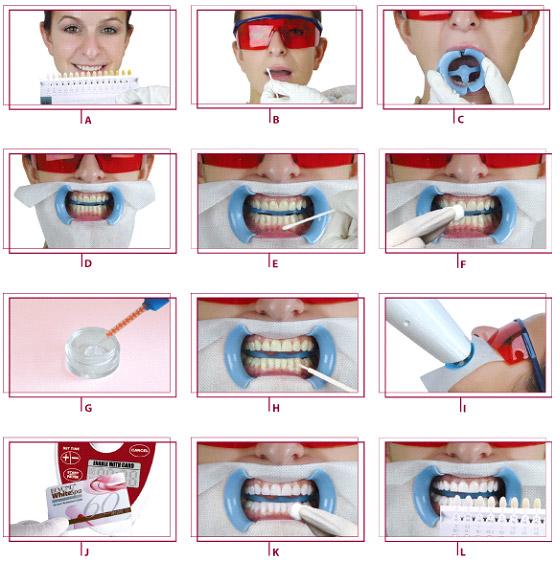Professional Tooth Whitening Methods
Professional whitening uses of high-concentration bleaching gels that are not available over the counter. Teeth whitening done in a professional dental setting is a safe, effective way to brighten your smile.
There are two methods of professional tooth whitening
In-Office Whitening —This technique offers the fastest results with the most powerful whitening solutions available. The results will be obvious immediately.
Step
First, your gums and tooth-root surfaces will be covered with a protective barrier to ensure your safety. A thin plastic device known as a retractor will hold your lips and cheeks away from your teeth as we apply a professional-strength hydrogen peroxide gel. A specialized light or laser activates the gel and allows bleaching to happen faster. The procedure takes around 1 to 1.5 hours. The number of appointment will depend upon the method used, how severe your stains are and how white you want your teeth to be. Different types of stains respond differently to the treatment.
Take-Home Whitening (Tray bleaching) —This method need patient’s cooperation to ensure the best possible results and several weeks may be needed to achieve your desired level of whiteness. Tray bleaching is a type of professional whitening that uses custom-made trays and whitening gel only available through your dentist. The whitening gel is placed in custom-fitted trays that fit perfectly over your teeth. At-home professional tray whitening generally takes ten to 14 days, although you may notice results in as little as three to five days
Step for home
We will take a mold of your teeth and then have two thin, flexible plastic mouth trays custom-made for you — one for the top teeth and one for the bottom. You will fill the trays with whitening gel and then position the trays over your teeth. The trays are left in usually for about an hour at a time or during night time.
Disadvantages
- Results can be unpredictable, depending on factors such as age, heredity and the type of staining that is present.
- In-office bleaching is not a permanent solution. Shortly after treatment is completed, the teeth resume accumulating stains. Many dentists therefore recommend home maintenance follow-up with a lower-percentage bleach that can be kept on the teeth for longer periods of time.
|
In-Office Whitening |
Take-Home Whitening |
|
|
Treatment time |
Faster |
Slower |
|
Whiten |
More powerful in short period of time |
Less powerful |
|
Patient cooperation |
No need |
Need |
|
Taking impression |
No need |
Need |
|
Price |
More expensive |
Cheaper |
|
Sensitivity |
unpredictable |
unpredictable |
Tooth whitening enhances the brightness of natural teeth, but it’s not for everyone. Discuss it with your Dentist before you take action, especially if you have:
- Discolored or sensitive teeth
- White spots or decay on your teeth
- A bridge, crown, or other dental work (especially involving front teeth)
The most common reasons for teeth to get yellow or stained are:
- Using tobacco
- Drinking dark-colored liquids such as coffee, cola, tea and red wine
- Not taking good care of your teeth—calculus deposit
- Aging
- Fluorosis teeth
- Taking tetracycline drug during pregnancy
- Treated root canal tooth










